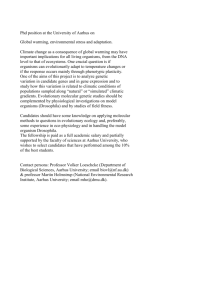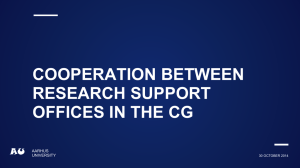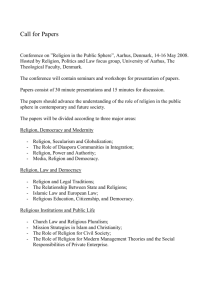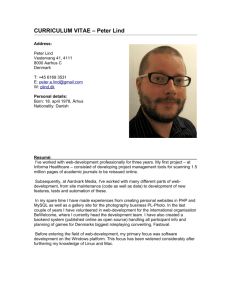Public participation in the framework of Industrial Emissions Directive
advertisement
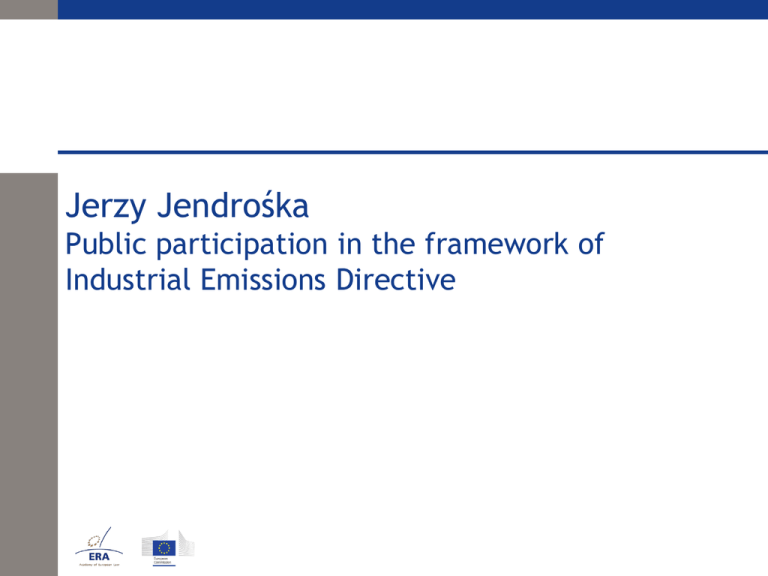
Jerzy Jendrośka Public participation in the framework of Industrial Emissions Directive Content Roots and historical development Aarhus Convention and its status in EU law „Aarhus” issues in IED – overview Public and public concerned Access to information Public participation Access to justice Issues of concern Roots and historical development German medieval local regulations – Prussian Industrial Code 1845 – napplications for permits for new installations or for substantial changes are made available for an appropriate period of time to the public, to enable it to comment on them before the competent authority reaches its decision. That decision, including at least a copy of the permit, and any subsequent updates, must be made available to the public. Aarhus Convention -1998 – – applications for authorization and the decisions of the competent authorities are made available to the public concerned in accordance with procedures provided for in the national law Directive 96/61/EC IPPC – public participation in granting industrial licenses for potentially harmful activities Directive 84/360/EEC of 28 June 1984 on the combating of air pollution from industrial plants – noxious and strenuous activities could not be carried out without the consent of the neighbours Political context framework Public Participation Directive 2003/36 amends IPPC Directive to implement Aarhus Convention Aarhus Convention Convention on Access to Information, Public Participation in Decision-making and Access to Justice in Environmental Matters – 1998 - adopted and signed in Aarhus (Denmark) – 2001 - entry into force Aarhus Convention as a benchmark – Draft Recommendations on Public Participation in Decision-making in Environmental Matters (Draft 2013) Aarhus Convention in EU – part of the acquis – Member States implement Aarhus via EU law Role of the Aarhus Compliance Committee (ACC) – nine independent members having „recognised competence” – elected to serve in personal capacity – regional balance Legal force Findings and recommendations of CC – Findings • compliance or non-compliance – Recommendations • steps to be taken by Party concerned • steps to be taken by MOP Adoption by MOP – declaration of non-compliance – caution (one issued -on Ukraine) – suspension of rights and priviliges Direct effect of Aarhus Convention Direct effect at EU level – Case C-240/09 Lesochranarske: art.9.3 has no direct effect but standard test of direct effect applicable Direct effect in Member States – no direct effect because of article 3.1 („Each Party shall take the necesary legislative, regulatory and other measures..”) – verdicts in Czech Republic and Poland – each provision separately judged (ie. paragraphs 1,2,3 and 7 of Art.6 produce direct effect according to Conseil d’Etat in France) „Aarhus” issues in IED - overview Recital 27 Definitions of the public and public concerned Access to information and public participation in the permit procedure (IPPC) – art.24 Access to justice (IPPC) – art.25 Public participation and information for incineration plants – art. 55 Specific provisions on – exchange of information and co-operation with NGOs – public disclosure of certain information Annex IV on the procedure for public participation in decision-making Recital 27 In accordance with the Århus Convention on access to information, public participation in decision-making and access to justice in environmental matters effective public participation in decision-making is necessary to enable the public to express, and the decision-maker to take account of, opinions and concerns which may be relevant to those decisions, thereby increasing the accountability and transparency of the decision-making process and contributing to public awareness of environmental issues and support for the decisions taken. Members of the public concerned should have access to justice in order to contribute to the protection of the right to live in an environment which is adequate for personal health and well-being. The public and public concerned definition (16) ‘the public’ means one or more natural or legal persons and, in accordance with national law or practice, their associations, organisations or groups; – definition identical as in Aarhus 917)‘the public concerned’ means the public affected or likely to be affected by, or having an interest in, the taking of a decision on the granting or the updating of a permit or of permit conditions; for the purposes of this definition, nongovernmental organisations promoting environmental protection and meeting any requirements under national law shall be deemed to have an interest – definition slightly modified to make it IPPC permit specific The public and public concerned - nondiscrimination clause Art. 3.9 – Within .. this Convention, the public shall have access to information, have the possibility to participate in decision-making and have access to justice in environmental matters without discrimination as to citizenship, nationality or domicile and, in the case of a legal person, without discrimination as to where it has its registered seat or an effective centre of its activities. The public and public concerned – foreign public No obligation to translate the notification and other documents into English – (ACC/51/Romania) Draft Recommendations on Public Participation – The environmental impacts of activities subject to the Convention may occur across national borders. In accordance with the requirement in article 3, para. 9, of the Convention, the public must have the possibility to participate in decisionmaking under the Convention without discrimination as to citizenship, nationality or domicile.. – To this end: • The legal framework should not contain anything that discriminates against the public from other countries participating in decision-making in the country of origin that may affect them; • Steps should be taken to put in place arrangements with other countries, in particular with neighbouring or downstream countries or those with shared natural resources (whether within existing agreements on transboundary cooperation or on transboundary impact assesment or otherwise) to facilitate the reciprocal participation of those countries’ public in decision-making under the Convention that may affect them. Access to information – art. 24 IED Obligation to „make available to the public”: – information regarding the permit, its conditions etc – Information regarding • Post-closure measures • Results of monitoring Obligation to make certain information available via Internet Subject to restrictions in Art.4.1 and 2 of Directive 2003/4 on access to environmental information, including – Restrictive interpretation of grounds for refusal – Obligation of weighing interests for– and against- the disclosure – Exemption to exemptions – no refusal in case of information on emissions Access to information – issues of concern Clear requirement to make information available via Internet (art.24.2 a), b) and f IED) in the light of art. 5.3 d) Aarhus as implemented by art 7 .2 f) of Directive 2003/4/EC - why not also c),d)and e)? what it means via internet - through „electronic data bases” or „upon (electronic) request ?? Art 19 IED - information about development in BAT – „make available” - language to address „passive acces” (ie upon request) – to „public concerned” limatation of general right under Directive 2003/4/EC which gives acces to „the public”!!! Public participation – general rules and steps in the procedure General rules – Early public participation (art.6.4) – Reasonable time-frames (art.6.3) Steps in the procedure – – – – – Notification –art 6.2 Access to relevant information – art.6.6 Possibility to submit comments – art.6.7 Due account taken of public comments – art.6.8 Decision taken notified and accesible to the public- art.6.9 Early public participation Aarhus Convention (Art.6.4) – Each Party shall provide for early public participation, – when all options are open – and effective public participation can take place IED –art. 24 – 1. Member States shall ensure that the public concerned aregiven early and effective opportunities to participate in the following procedure .. Basic issues – Does „early…when all options are open” • relates to sequence of decisions (Delena Wells case)? • relates to particular decision (scoping in EIA)? • both? – Can public participation after construction is finished be considered „early” (ACC/C/17 – EC case)? Reasonable time-frames Aarhus Convention (Art.6.3) – The public participation procedures shall include reasonable time-frames for the different phases, allowing sufficient time for informing the public in accordance with paragraph 2 above and for the public to prepare and participate effectively during the environmental decision-making” IED (annex IV.5) – Reasonable time-frames for the different phases shall be provided, allowing sufficient time to inform the public and for the public concerned to prepare and participate effectively in environmental decision-making subject to this Annex. Time frames – issues for consideration Phases – – – – Notification Inspection of relevant documents Submission of comments Consideration of comments (ACC/C/3 Ukraine) Fixed vs diversified time-frames Initial date Timing – traditional holiday season (ACC/C/24 Spain) Time frames - examples Not reasonable time-frames – „The time-frame of only ten working days, set out in the Lithuanian EIA Law, for getting acquainted with the documentation, including EIA report, and for preparing to participate in the decision-making process concerning a major landfill does not meet the requirement of reasonable time-frames” (Case CCC/C/16 Lithuania) Reasonable time-frames – „the announcement of the public inquiry...provided a period of approximately 6 weeks for the public to inspect the documents and prepare itself for the public inquiry ...the public inquiry ...provided 45 days for public participation and for the public to submit comments, information, analyses or opinions relevant to the proposed activity... The … provision of approximately 6 weeks for the public concerned to exercise its rights under article 6, paragraph 6, and approximately the same time relating to the requirements of article 6, paragraph 7.. meet the requirements of these provisions in connection with article 6, paragraph 3, of the Convention”(Case CCC/C/22 France) Notification – basic issues Aarhus (art.6.2) – Public notice or individually (case C-15 Romania) – Manner: • Adequate • Timely • Effective IED – Timely („sufficient time to inform the public and for the public.. to prepare and participate effectively” – compare with the previous version of EIA Directive!) – Adequate („nature of possible decisions”) – Effective („bill posting…or publication in local newspapers”) – still no clear indication that the public notice should be done in „adequate, timely and effective manner” as required in Art.6.2 Aarhus (see ACC/C/17 EC) „Adequate” notice „it has been clearly shown that what the public concerned was informed about were possibilities to participate in a decision-making process concerning “development possibilities of waste management in the Vilnius region” rather than a process concerning a major landfill to be established in their neighbourhood. Such inaccurate notification cannot be considered as “adequate” and properly describing “the nature of possible decisions” as required by the Convention.” (Case CCC/C/16 Lithuania) „Effective” notice „The requirement for the public to be informed in an “effective manner” means that public authorities should seek to provide a means of informing the public which ensures that all those who potentially could be concerned would have a reasonable chance to learn about proposed activities and their possibilities to participate” (Case CCC/C/16 Lithuania) „Therefore, if the chosen way of informing the public about possibilities to participate in the EIA procedure is via publishing information in local press, much more effective would be publishing a notification in a popular daily local newspaper rather than in a weekly official journal, and if all local newspapers are issued only on a weekly basis, the requirement of being “effective” established by the Convention would be met by choosing rather the one with the circulation of 1,500 copies rather than the one with a circulation of 500 copies. ” (Case CCC/C/16 Lithuania) Access to relevant information Aarhus Convention 9(Art.6.6) – – – – Free of charge All information relevant to decision-making As soon as available Exemption from general rules on access to information under art.4 – Relation to art 6.2 IED – convoluted scheme in Annex IV – „information other than that referred to..(point 2 referring to point 1) Possibility to submit comments – Art. 6.7 of Aarhus„ 7. Procedures for public participation shall allow the public to submit…any comments” Annex IV .3 IED – Possibility to submit comments -two equal methods – – „3. The public concerned shall be entitled to express comments and opinions to the competent authoority before a decision is taken” In writing In public inquiry (hearing) Any comments - no need to be motivated (ACC/C/16 Lithuania) Due account– art.6.8 Due account must be taken of public comments – obligation to read and consider seriously – but not always to accept all comments Any comments vs „reasoned or motivated comments” Sufficient time for authorities to consider comments ((ACC/C/3 Ukraine ) Annex IV IED 4. The results of the consultations held pursuant to this Annex must be taken into due account in the taking of a decision. Publicising the decision- art.6.9 Requirement – to notify the public promptly (ACC/C/8 Armenia) • about the decision • where it can be made available – to make it accesible to the public (ACC/C/3 Ukraine ) • publicly accesible registers • publicly accessible records of decisions Together with a statement on: – reasons – considerations Art.24.2 IED vs art.6.9 Aarhus N – „make available” (passive) vs „ inform” (active) – no „promptly” – no „in acordance with appropriate procedures” (as it was in IPPC) Public participation – in permitting (art 6 Aarhus) - scope of application Annex I revised – activities added ( for example 6.9-6.11 Annex I IED) – activities more precisely elaborated (for example point 5 Annex I IED) Needed thorough analysis of legal consequences for the scope of application Public participation in permitting (art 6 Aarhus) - incinerations Special legal regime for waste incineration – article 55 IED - • simplified public participation • applies to all – relation to art 24, 25 and Annex IV • which is meant to apply only to those in Annex no provision from Directive 2000/76/EC – „without prejudice ...to Directive 96/61/EC” – to cover standard IPPC regime (now art.24,25 and Annex IV IED) Public participation in permitting (art 6 Aarhus) - reconsideration/updating permits M Does art.24.1 d) covers only updating or also reconsideration? Public participation required only in case of Article 21.5 a) IED Art.6.10 Aaarhus require pp in rec/up „where appropriate” Why situations in art.21.5 b) and c) are not „appropriate”? Public participation in plans and programs (art 7 Aarhus) Art 32 IED - Transitional National Plan Art.23 IED – environmental inspection plan – plans „relating to the environment” – therefore subject to Art.7 Aarhus No requirement for public participation envisaged in IED Access to justice (art.9 Aarhus) Art.9.2 (relation to Art.6 and possibly other provisions) : – redress in case of abusing right to participate and/or – basis to challenge substantive and procedural legality Problems in legislations based on „protection of rights” with addressing – procedural legality (ACC/31/ Germany) – substantive legality (ACC/50/Czech Republic) – general environmental issues (ACC/48/ Austria) In IED (art.25) still no injunctive relief as envisaged in Art.9.4 Aarhus – despite it seems „appropriate” – despite change of the Treaty (under Lisbon Treaty EU has now clear competence in access to justice) Sufficient interest Conclusions There are serious flaws in IED – most „old” problems inherited from IPPC – some „new” problems added Problems can be rectified by – proper transposition – proper interpretation Aarhus Convention is also part of acquis IED should be interpreted in the light of Aarhus when transposed by and implemented in the Member States
